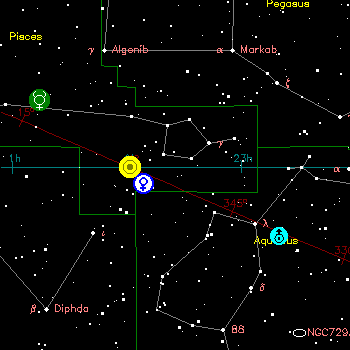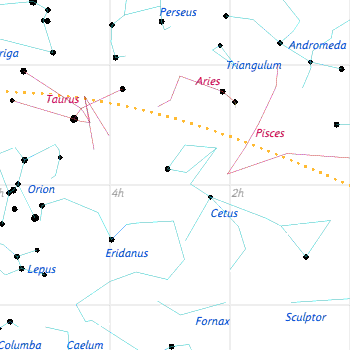The Vernal Equinox [Spring Equinox]
Definition: [Astrology Stations] [See also: Movement of the Vernal Equinox Point] Vernal means "arriving in the Spring time". Equinox literally means "equal night".
There are several definitions of the vernal equinox, depending on whether it is being thought of as an event in time, with respect to the length of the daytime, an event in time, with respect to the Sun and the Celestial Sphere or an event in space, with respect to Sun and the stars.
|
Time Defintion: Calendar Definition: The date on which the number of hours and minutes of daylight and night-time are equal - in Spring in the northern hemsiphere. This is either March 20 or March 21 [Gregorian calendar] each year. [It can vary slightly, primarily over the four-year leap year cycle.] Our Gregorian calendar was designed so that the vernal equinox lies on approximately the same date each year - the date it had in the year of the Council of Nicea [325 AD]. [Papal Bull, Inter Gravissimas, Pope Gregory XIII, 1582 AD] In the Roman, Julian Calendar the vernal equinox lay on 24 March, but it had slipped back by three days by the time of the Council of Nicea because of the innaccuracy of the Julian Calendar [introduced by Julius Ceasar in 45 BC]. Time Defintion: Sun and Celestial Equator: The date and time on which the Sun crosses the Celestial Equator heading northwards, as seen from Earth. This definition is a bit misleading as the Sun isn't moving - the Earth is. Hence, a better definition might be the date and time on which the Earth's movement in orbit around the Sun gives the illusion that the Sun is crossing the Celestial Equator heading northwards. Space Definition: Sun's Position Against the Stars: The stars which the Sun lies in front of, as seen from Earth, when the day and night are of equal length in the Spring [northern hemisphere]. Or more accurately the stars which lie behind the exact point where the line of Ecliptic crosses the line of the Celestial Equator, as seen from Earth, in the Spring [northern hemisphere]. These stars, now and for the next few centuries, belong to the second fish of Pisces, the Fishes. Vernal Equinox Point: This stellar position is called the Vernal Equinox Point, the Fiduciary Point [fiduciary means founded on trust], or the First Point in Aries. The latter because when the rules of astrology which apply to this were first formulated, the vernal equinox point was in Aries [see below]. It is now in Pisces. Why is this Date Important in Astrology? Because of the tradition, dating back to Ptolemy and earlier, that the vernal equinox is the start of the astrological year. One of the Zodiacs in use today, the Tropical Zodiac, still uses this traditional date as its starting point. Why is this Stellar Position Important in Astrology? There are two reasons for this: its importance in the Movement of the Ages; its importance in the defintion of the Zodiacs. (a) Movement of the Ages: The vernal equinox point changes, against the stars, as the centuries pass. In other words the vernal equinox point a thousand years back was at a different place - further to the left, relative to the Ecliptic - in constellation of Pisces, the Fishes to the one we see it in today. [See Movement of the Vernal Equinox Point.] Assuming this position has changed at the same rate for the last several thousand years, then in 500 BC it was in a different constellation entirely, Aries, the Ram. We would now say that the year 500 BC was in the astrological Age of Aries. When the vernal equinox point moves between constellations in this fashion we call it the Movement of the Ages and say that the Astrological Age has changed. (b) The Zodiacs: When Ptolemy's [c 130 - 170 AD] rules of astrology were formulated, the vernal equinox point was very close to the start of the constellation of Aries. Hence, Ptolemy [See Tetrabiblos i Chapter 22], defined the start of Aries as being defined by the vernal equinox point. This Zodiac is what we today call the Tropical Zodiac, and this particular Zodiac is still defined this way. However, the connection between vernal equinox point and Aries is no longer correct because the vernal equinox point has moved. The vernal equinox point is currently in Pisces [see diagram above right]. This poses severe problems for a Zodiac which still defines it as being in Aries. [See Tropical Zodiac for further information on this problem.] Why the northern hemsiphere? There are only two dates each year on which day and night could have the same length, Spring Equinox and Autumn Equinox. [To see why this is, see Celestial Equator.] Vernal Equinox refers specifically to the Spring Equinox in the northern hemisphere [the date on which it is also Autumn equinox in the southern hemipshere], as, since Ptolemy [See Tetrabiblos i Chapter 22], Western Tropical Zodiac astrology has marked this as the starting point of the solar astrological year. In Roman times Europeans did realise that the Earth was a globe. And there is strong evidence that the Ancient Egyptians sent sea-faring expeditions which may have reached the southern tip of Africa, hence crossing the equator into the southern hemisphere. However, there seems to have been no awareness by the Romans that when it was Spring Equinox in the northern hemispshere, it was Autumn Equinox in the southern hemipshere, nor that Spring Equinox in the southern hemisphre would not occur until six moths later, nor that this would affect the weather of the southern hemisphere, making it different to that of the northern hemsipshere. |
The dates and times of the vernal equinox assuming a point-like Sun and no atmospheric refraction. [In reality the day of exactly equal daylight and night time happens within a few days of, or on the day of, the Vernal Equinox.] *The times are in Universal Time, i.e. Greenwich Mean Time. For your own time zone add on or take off the appropriate time difference from London, England. The times are derived form the Celestial defintion of the Vernal Equinox [see below left.]

Vernal Equinox 2005 Star chart for 20 Mar 05, of the Vernal Equinox Point. The Sun is in yellow, the path of the Ecliptic is shown in red and the horizontal gray line in the center of the image is the Celestial Equator. The Sun, at vernal equinox, lies [by definition -see Celestial Equator] just at the point where the Ecliptic and the Celestial Equator meet - the Vernal Equinox Point. In March 2005 this point is seen against the stars of the constellation of Pisces, the Fishes, towards the head of the second fish [up and to the right of the Sun] [Note, because this point in the sky is where the Sun is you would not actually be able to see these stars on 20 Mar 05, unless there was an Eclipse - which there can not be as, as can be seen from the chart, the Moon is not close to the Sun on that date.] On the chart, Mercury in shown blue and white, Venus in Green and Uranus in Grey. The chart contains the Pisces-Aquarius section of the night sky. The green lines are the constellation boundaries. The white lines join the stars of each constellation to make the constellation figure. Click on the above picture for a large version.

The Vernal Equinox on Star Maps The vernal equinox marks the starting point for most star charts. In the section of a star map shown above, the vernal equinox point lies far right where the dotted and gray lines intersect. [So the far right edge of the map is a great circle connecting the vernal equinox point and the North and South Celestial Poles.] The dotted line is the the Ecliptic and the gray line the Celestial Equator. Because of the Movement of the Vernal Equinox Point, the gird of lines on the star chart above moves slowly with respect to the stars. Hence, every 50 years or so we need to re-draw all our star maps. It is not that the stars move, but our starting point for mapping them does. It's as if the Greenwich Meridian slowly moved with time instead of staying in place in London - we would always have to be redrawing maps of the Earth with new longitude positions on them. |
© Dr Shepherd Simpson, Galactic Astrologer
The Galactic Astrologer
Do you want to know more about Galactic Astrology ?
Then enter the Galactic Zodiac
See the new Astrological Index for the meaning of other astrological words and phrases